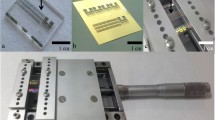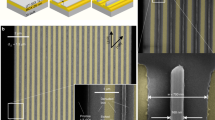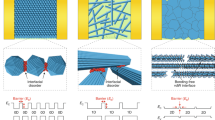Abstract
Recently, we showed that thin film stresses can be used to form well aligned and complex nanowire structures [1]. Within this approach we used stress to introduce cracks in a thin film. Subsequent vacuum deposition of metal leads to the formation of a metal layer on the thin film and of metal nanowires in the cracks of the film. Removal of the thin film together with the excess metal cover finishes the nanowire fabrication on the substrate. As stress can be intentionally introduced by choosing an appropriate thin film geometry that leads to a stress concentration, the cracks and consequently the nanowires can be well aligned. Meanwhile, we have demonstrated how to form thousands of parallel aligned nanowires, x-and y-junctions or nanowires with macroscopic contacts for sensor applications, simply by applying fracture mechanics in thin films. Christiansen and Gösele called this approach “constructive destruction” in a comment in Nature Materials [2]. This gives a hint how to overcome some problems of the approach, arising from the limits of thin film fracture. A generalization of the fracture approach by being “more destructive” can overcome this limitations. For example, it is difficult to form pairs of parallel wires with a nanometer distance of the pair, but a micrometer separation between the individual pairs. Structures like this are useful for many contact applications including sensor arrays or field effect transistors. As well as thin film fracture, thin film delamination can be well controlled by fracture mechanics. Our latest experiments show that the combination of both, fracture and delamination, forms an ideal shadow mask for vacuum deposition. Cracks with delaminated sides were used as templates for the deposition of pairs of parallel wires consisting out of different materials with only a few 10 nm separation. First, a metal was sputter deposited under an angle of approx. 45° through the delaminated crack, which was used as a shadow mask. Afterwards, a second deposition metal is deposited under the opposite 45° angle with respect to the sample normal, having the crack located in the middle between both deposition sources. The angle, the delamination height and the crack width determine the separation of the nanowire contacts. We present several examples which show how these mechanisms of mechanical failure of thin films can be turned into useful templates for various nanostructures. We will focus here on two thin film systems, that can be easily deposited in every lab. These are wet chemically deposited photo-resist and flash evaporated amorphous carbon. These examples are compared with finite element simulations of the thin film stress with the ANSYS program. Moreover, we show how the delamination cracks can be also used as masks for the removal of material. Channals with a width down to 20 nm produced by ion beam sputtering are shown.
Similar content being viewed by others
References
R. Adelung, O.C. Aktas, J. Franc, A. Biswas, R. Kunz, M. Elbahri, J. Kanzow, U. Schürmann, and F. Faupel, Nature Materials, 3, 375 (2004).
S. Christansen and U. Gösele, Nature Materials, 3, 357 (2004).
R. Adelung, L. Kipp, J. Brandt, L. Tarcak, M. Traving, C. Kreis, and M. Skibowski, Appl. Phys. Lett 74, 3053 (1999).
B. E. Alaca, H. Sehitoglu, and T. Saif, Appl. Phys. Lett. 84, 4669 (2004).
Y. Chen, D. A. A. Ohlberg, X. Li, D. R. Stewart, R. S. Williams, J. O. Jeppesen, K. A. Nielsen, J. F. Stoddart, D. L. Olynick, and E. Anderson, Appl. Phys. Lett. 82, 1610 (2003).
R.F. Cook and Z. Suo, MRS Bulletin, 27, 45 (2002).
M. M. Deshmukh, D. C. Ralph, M. Thomas, and J. Silcox, Appl. Phys. Lett. 75, 1631 (1999).
Author information
Authors and Affiliations
Rights and permissions
About this article
Cite this article
Adelung, R., Elbahri, M., Rudra, S.K. et al. Employing Thin Film Failure Mechanisms to Form Templates for Nano-electronics. MRS Online Proceedings Library 863, B7.3 (2004). https://doi.org/10.1557/PROC-863-B7.3/O11.3
Published:
DOI: https://doi.org/10.1557/PROC-863-B7.3/O11.3




